

Spatial alchemy : Why proximity matters for innovation. Spatial alchemy is an Economist Intelligence Unit report commissioned by Dubai Tourism.

It examines the relationship between physical proximity, geography and innovation. The report is based on desk research and expert interviews. The Economist Intelligence Unit wishes to thank Jung Won Sonn, assistant professor of urban economic development at University College London, and Rune Dahl Fitjar, professor of innovation studies at the University of Stavanger Business School in Norway. The author was Denis McCauley.
The editor was Adam Green. Key findings Digital technology once promised ‘the death of distance’, allowing workers to collaborate from anywhere. At its best, innovation needs both physical and digital – yet personal – interactions, augmented by communications tools with the outside world. How to Disrupt Your Day by Improving Your Habits. Breaking out of your daily routines can be a powerful way to unlock great new ideas, both personally and professionally.
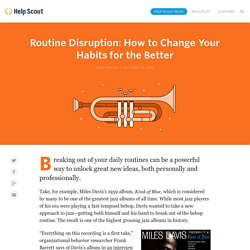
Free brave blue-skies researchers to refuel economic growth. Aaron Swartz on the Parpolity System. One of the most compelling visions for rebooting democracy adopts this system of abstraction for politics.
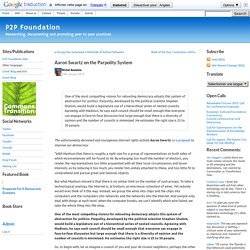
Parpolity, developed by the political scientist Stephen Shalom, would build a legislature out of a hierarchical series of nested councils. Agreeing with Madison, he says each council should be small enough that everyone can engage in face-to-face discussion but large enough that there is a diversity of opinion and the number of councils is minimized. The Secret to Creativity, Intelligence, and Scientific Thinking: Being Able to Make Connections -
When we shared this image from the @buffer Twitter account a while back, it got me thinking.
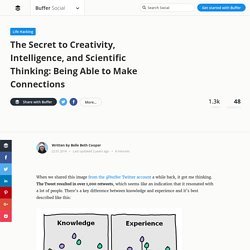
The Tweet resulted in over 1,000 retweets, which seems like an indication that it resonated with a lot of people. There’s a key difference between knowledge and experience and it’s best described like this: The original is from cartoonist Hugh MacLeod, who came up with such a brilliant way to express a concept that’s often not that easy to grasp. The image makes a clear point—that knowledge alone is not useful unless we can make connections between what we know. Whether you use the terms “knowledge” and “experience” to explain the difference or not, the concept itself is sound. Lots of great writers, artists and scientists have talked about the importance of collecting ideas and bits of knowledge from the world around us, and making connections between those dots to fuel creative thinking and new ideas.
Intelligence and connections: why your brain needs to communicate well with itself. Maker Inventions at Intel Developer Forum 2014. The futuristic jets, humans, and Star Wars designs of Stephen Chang. These Architects Have Ingenious Plan For Brazil's World Cup Stadiums. X/wp-content/uploads/2014/05/2014-06-UTILIT-EASERS1.pdf?utm_content=buffercc0ef&utm_medium=social&utm_source=twitter.com&utm_campaign=buffer. Evgeny Morozov: Hackers, Makers, and the Next Industrial Revolution. In January of 1903, the small Boston magazine Handicraft ran an essay by the Harvard professor Denman W.
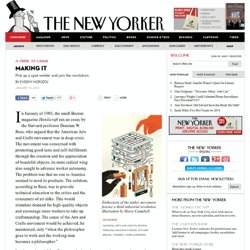
Ross, who argued that the American Arts and Crafts movement was in deep crisis. The movement was concerned with promoting good taste and self-fulfillment through the creation and the appreciation of beautiful objects; its more radical wing also sought to advance worker autonomy. The problem was that no one in America seemed to need its products. The solution, according to Ross, was to provide technical education to the critics and the consumers of art alike. Free 21 Days of Inspiration Booklet. “Special Forces” Innovation: How DARPA Attacks Problems. Artwork: Monika Grzymala, The River, 2012, Handmade cotton rag paper, fishing line and wire, weaving material of local plants Over the past 50 years, the Pentagon’s Defense Advanced Research Projects Agency (DARPA) has produced an unparalleled number of breakthroughs.
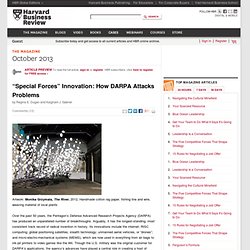
Arguably, it has the longest-standing, most consistent track record of radical invention in history. Its innovations include the internet; RISC computing; global positioning satellites; stealth technology; unmanned aerial vehicles, or “drones”; and micro-electro-mechanical systems (MEMS), which are now used in everything from air bags to ink-jet printers to video games like the Wii. Though the U.S. military was the original customer for DARPA’s applications, the agency’s advances have played a central role in creating a host of multibillion-dollar industries. Delivering World-Class Health Care, Affordably.
India might be the last place on earth where you’d expect to find health care innovation.

Government programs have finally brought some infectious diseases under control, but the nation’s ability to meet the basic medical needs of its citizens remains abysmal. Despite robust economic growth over the past two decades, the infant mortality rate is three times higher than China’s and seven times greater than that of the U.S.
Of the 2 million Indians in need of heart surgery, fewer than 5% get it. The majority of the country’s estimated 63 million diabetics and 2.5 million cancer sufferers haven’t been diagnosed, let alone treated. Seventy percent of India’s 12 million blind people could be cured by a simple surgery—if it were available to them.